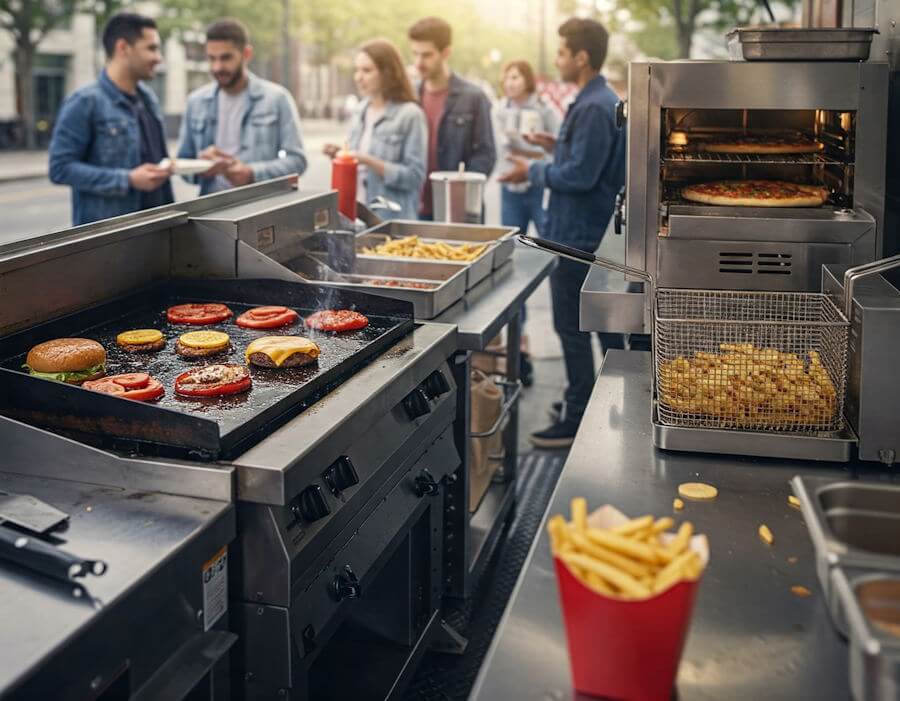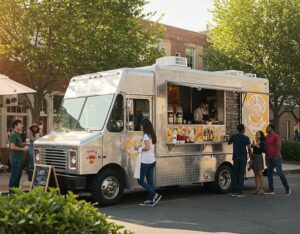Starting a food truck business is an exciting venture that combines culinary creativity with the flexibility of mobile service. Food trucks have gained immense popularity over the years, offering an array of dining options ranging from gourmet meals to unique street food. However, the success of a food truck operation heavily relies on having the right equipment. This equipment not only facilitates cooking and food preparation but also enhances overall efficiency and ensures compliance with food safety regulations.
Having a well-equipped food truck is paramount. Quality cooking appliances, storage solutions, and serving tools enable food truck operators to prepare meals quickly and effectively, which is especially crucial when catering to high-volume customer demand during events or busy shifts. Additionally, proper equipment contributes to food safety standards, ensuring that all food is stored and cooked at the correct temperatures, thus preventing potential health hazards. By investing in the right tools, operators can consistently deliver good quality food that meets customer expectations.
Moreover, the variety and reliability of equipment have a direct impact on customer satisfaction. Well-functioning equipment reduces waiting times, allowing for a smoother service experience that can make customers more likely to return. Furthermore, high-quality utensils and appliances contribute to the overall perception of a food truck brand, enhancing its reputation in a competitive market. As the food truck industry continues to grow, a well-organized checklist for food truck essentials will serve as an invaluable resource for both new and established operators, ensuring they are fully prepared to thrive.
Cooking Equipment Fundamentals
When operating a food truck, selecting the right cooking equipment is vital for ensuring the efficient preparation of menu items. The essential cooking appliances can significantly impact service quality, speed, and overall customer satisfaction. Key equipment includes grills, fryers, ovens, and stovetops. Each of these appliances serves a unique purpose and can enhance the overall cooking process.
Grills are often a staple in food trucks, particularly for those serving burgers, hot dogs, or traditional barbecue fare. When selecting a grill, consider factors such as size, fuel type (gas or charcoal), and temperature control features. Ensuring adequate grilling surface area is crucial, especially during busy service hours when quick food preparation is required.
Fryers are equally important, especially for food trucks focusing on fried snacks like French fries, onion rings, or chicken tenders. The capacity of the fryer should align with the anticipated volume of food. Energy-efficient models can reduce operating costs while providing consistent results. Additionally, a fryer with a filtration system can extend oil life, promoting cost savings and better food quality.
Ovens also play a critical role for food truck operators who bake items such as pizzas or pastries. Choosing between convection and traditional ovens can depend on space constraints and the desired cooking speed. Convection ovens typically offer faster cooking times and even heat distribution, making them a popular choice in mobile kitchens.
S stovetops are essential for food trucks that require sautéing, boiling, or simmering. A dual-burner stove can provide versatility, allowing chefs to multitask efficiently. When selecting stoves, consider factors such as space utilization, fuel type, and ease of cleanup.
In conclusion, the selection of cooking equipment in a food truck hinges on the specific cuisine offered, the expected volume of service, and the need for energy efficiency. By understanding these fundamentals, food truck operators can make informed choices that streamline operations and enhance customer satisfaction. Establishing a well-equipped mobile kitchen is instrumental in achieving success in this competitive sector.
Refrigeration and Food Storage Solutions
When operating a food truck, maintaining proper refrigeration and food storage is vital for food safety and quality. Essential equipment includes commercial refrigerators, freezers, and food warmers. Each of these appliances plays a significant role in ensuring that ingredients and prepared dishes are kept at safe temperatures, thereby helping to prevent foodborne illnesses.
Commercial refrigerators should be selected based on specific needs, including size, capacity, and energy efficiency. It is advisable to choose models that meet health department regulations and provide adequate temperature control, ideally maintaining temperatures below 40°F (4°C) for stored perishables. Likewise, freezers are crucial for long-term storage of ingredients. Models with adjustable shelving can enhance organization, making it easy to access various food items quickly.
Food warmers, on the other hand, are essential for keeping prepared dishes at safe temperatures before serving. They should be used strategically during service periods to ensure that hot foods remain above 140°F (60°C). Additionally, warming stations can facilitate efficient service during peak hours by reducing wait times and maintaining food quality.
In order to comply with health regulations, it is necessary to regularly check and document the temperature of refrigeration units. This practice not only helps ensure food safety but also provides proof of compliance during health inspections. Additionally, maintaining cleanliness within refrigeration units is a must; regular cleaning cycles help prevent contamination and extend equipment longevity.
Effective organization of food storage within the truck is equally important. Utilizing clear containers and labeling can greatly assist in quickly identifying ingredients while maximizing available space. Prioritizing proper airflow within refrigeration systems and avoiding over-stocking will further enhance efficiency and ensure consistent product quality.
Cleaning and Sanitation Equipment
Maintaining cleanliness and proper sanitation is a fundamental aspect of operating a food truck, ensuring both food safety and adherence to health regulations. The presence of effective cleaning and sanitation equipment is vital to achieving high standards of hygiene in a mobile food service environment. Essential components of this equipment list include sinks, dishwashers, and a range of sanitation supplies.
Firstly, commercial sinks serve as the cornerstone of food truck sanitation. Typically, a food truck should be equipped with separate sinks designated for washing, rinsing, and sanitizing. These three-compartment sinks allow for an effective cleaning process, where utensils and cookware can be thoroughly scrubbed and sanitized, minimizing the risk of cross-contamination. Moreover, adhering to local health code requirements often mandates the presence of handwashing sinks for food handlers, facilitating proper hand hygiene before and after handling food items.
In addition to sinks, a reliable commercial dishwasher plays a crucial role in maintaining sanitation standards within the food truck. The efficiency of a dishwasher ensures that high volumes of dishes and utensils can be cleaned and sanitized swiftly, allowing for seamless food preparation and service. When selecting a dishwasher, operators should consider models that meet health department standards and can accommodate the operational demands of a food truck.
Complementing these fixtures, a variety of sanitation supplies, including biodegradable cleaning solutions, disposable gloves, and sanitizing wipes, are essential for day-to-day cleaning and upkeep. Following strict procedures, such as regularly cleaning surfaces and equipment, not only supports health and safety mandates but also fosters a positive perception among customers who prioritize dining in hygienic environments.
In conclusion, investing in the appropriate cleaning and sanitation equipment is indispensable for food truck operators. By systematically implementing these tools, food trucks can maintain exceptional hygiene practices that satisfy regulatory requirements, enhance customer trust, and create a safe dining experience.
Serving and Point-of-Sale System Essentials
To ensure smooth operations in a food truck, adhering to a well-defined serving and point-of-sale (POS) system is essential. The right equipment not only enhances customer service but also streamlines the overall transaction process. It begins with the fundamentals, including serving utensils and containers. High-quality serving utensils such as spatulas, tongs, and ladles should be selected based on their durability and ease of use. Moreover, containers for food should be chosen to maintain proper temperature and presentation, with a focus on sustainability through eco-friendly materials when possible.
Equally important is the implementation of an efficient point-of-sale system. A robust POS system serves multiple functions—managing sales, tracking inventory, and generating sales reports. It automates the ordering process, reduces wait times for customers, and minimizes human error during transactions. When selecting a POS system, aspiring food truck owners should consider various factors, including ease of use, integration capabilities with other software, and customer support services. Additionally, mobile POS systems can be particularly useful for food trucks, enabling teams to take orders and process payments directly from the point of service, improving customer satisfaction. It is advisable to review customer feedback and case studies to identify systems that have proven successful within the industry.
Finally, consider equipment that can accommodate various payment methods, such as credit cards and mobile wallets, to cater to a broader consumer base. Offering flexibility not only meets customer preferences but also can potentially increase sales. In conclusion, carefully selecting the right serving utensils, food containers, and a suitable point-of-sale system can drastically improve efficiency and customer experience in your food truck operation, setting the foundation for success in the competitive food service landscape.
Safety and Compliance Equipment
Operating a food truck involves navigating numerous regulations aimed at ensuring both customer safety and legal compliance. It is imperative for food truck operators to equip their vehicle with essential safety and compliance equipment. This equipment not only satisfies regulatory requirements but also contributes to a safe and healthy environment for both employees and patrons.
One of the primary items that food truck operators must have is a fire extinguisher. Fire hazards are a significant concern in any cooking environment, and food trucks are no exception. The National Fire Protection Association (NFPA) recommends that food trucks equipped with cooking appliances carry a fire extinguisher rated for Class K, as it is specifically designed to extinguish kitchen grease fires. Regular inspections and maintenance of this essential equipment are necessary to ensure it operates effectively when needed.
Another crucial item on the safety checklist is a comprehensive first-aid kit. A well-stocked first-aid kit should include items such as adhesive bandages, antiseptics, gauze, and gloves. This equipment is vital for addressing minor injuries that can occur in the fast-paced environment of a food truck. Training staff on first-aid procedures is equally important to promote a culture of safety and preparedness.
Moreover, compliance with health regulations mandates the presence of documentation related to health inspections. Food truck operators should keep a copy of their latest health inspection report accessible at all times. This not only ensures transparency and accountability but also provides peace of mind to customers, knowing that the food they consume meets health standards.
In conclusion, adhering to safety and compliance regulations is not only a legal obligation for food truck operators but also a fundamental practice that fosters trust and safety within the community. By equipping their trucks with the necessary safety equipment, operators can create a secure environment for their customers and themselves.
Utilities and Power Supply Considerations
When operating a food truck, understanding the utilities and power supplies required is crucial for ensuring smooth operations. Food trucks typically depend on electricity and fuel to power cooking equipment, refrigeration, and lighting. The first step in this process is to assess your power needs based on the equipment you will utilize. This includes evaluating appliances like deep fryers, grills, refrigerators, and freezers to determine the total wattage required.
Generators are a common choice for supplying electricity in food trucks, especially in locations where access to power outlets is limited. Select a generator with enough capacity to handle your equipment, while taking into account future expansions or additional appliances that you might want to incorporate. Moreover, ensure the generator is suitable for both outdoor and indoor use, as certain models emit harmful fumes that require proper ventilation and safety measures.
Another essential fuel source for food trucks is propane. Commonly used for cooking equipment, heating, and sometimes refrigeration, propane tanks must be adequately protected and regularly maintained. Adhering to safety guidelines when using propane includes checking for leaks, proper tank ventilation, and ensuring that equipment is compliant with local safety regulations.
Backup options, such as additional generators or battery-powered equipment, should also be considered to mitigate any disruptions caused by power outages or equipment failure. In many cases, food truck operators can benefit from investing in a dual fuel system that allows for both propane and electrical operation. Prior planning regarding utilities and power supplies not only ensures compliance with regulations but also enhances the reliability and efficiency of your food truck business.
Storage and Organization Solutions
Effective storage and organization are crucial aspects of running a successful food truck operation. As space is typically limited in food trucks, it becomes essential to utilize every inch wisely. Implementing innovative storage solutions can enhance not only organization but also operational efficiency, allowing staff to execute tasks swiftly during peak hours.
One valuable approach to maximizing space is through the use of collapsible storage solutions. These items can be expanded when needed and tucked away when not in use, creating flexibility in your food truck’s layout. Collapsible bins or crates are perfect for storing dry goods and can easily be packed away, reducing clutter when they are not required. Additionally, adjustable shelving can help in creating vertical storage space, making it easier to access items while minimizing the footprint.
Organizational tools, such as labeled bins and racks, significantly contribute to a systematic work environment within the truck. Clearly labeled storage containers ensure that staff can quickly find the ingredients or tools they require, streamlining the food preparation process. Utilizing wall-mounted racks for utensils and equipment not only saves counter space but also helps in maintaining cleanliness and reducing the risk of accidents.
Moreover, establishing a routine for maintaining order during service is critical. Periodically checking stock levels, reorganizing supplies after peak hours, and training staff on proper storage techniques can help keep the food truck clutter-free. This proactive approach minimizes stress during busy periods and fosters a seamless workflow, ultimately enhancing customer experience. Incorporating these storage and organization solutions is fundamental for any food truck aiming to operate effectively and efficiently.
Conclusion and Final Tips
In the food truck industry, the significance of a comprehensive equipment checklist cannot be overstated. Having a detailed list not only enhances operational efficiency but also ensures that food truck operators are prepared to meet customer demands effectively. A well-planned setup allows operators to provide high-quality service consistently, which is critical for success in this competitive field. An optimal equipment inventory supports day-to-day tasks, from food preparation to serving, allowing for a smoother workflow.
For both newcomers and seasoned food truck operators, there are several strategies to continuously improve and adapt their setups. First and foremost, regularly reassessing equipment needs based on changing customer preferences or emerging food trends is vital. It is advisable to invest in versatile kitchen tools that can cater to a variety of menu items, thus expanding service offerings without needing extensive additional equipment. Furthermore, seeking feedback from customers can provide valuable insights into potential enhancements that could elevate the overall dining experience.
Moreover, keeping abreast of industry innovations and trends is essential. Investing in technology and appliances that promote efficiency, such as point-of-sale systems or energy-efficient cooking equipment, can yield significant long-term benefits. Also, participating in food truck festivals or community events offers operators opportunities to network, share experiences, and discover new best practices that can aid operational improvement.
Ultimately, success in the food truck industry hinges on the ability to adapt and innovate continually. By maintaining a comprehensive equipment checklist and remaining committed to evolving with the market, food truck operators can enhance their offerings and ensure sustained success in this vibrant gastronomic landscape.




